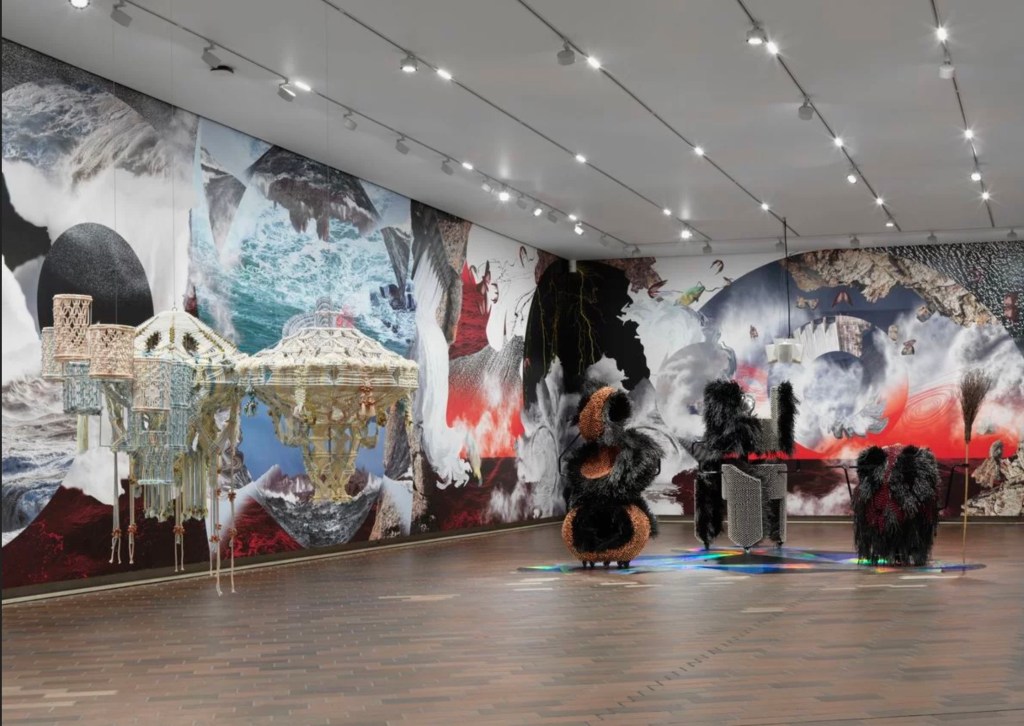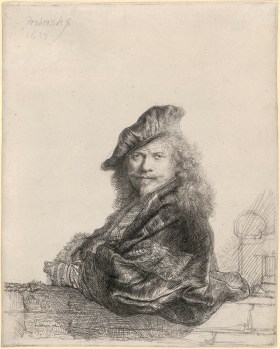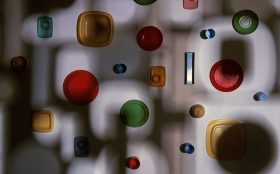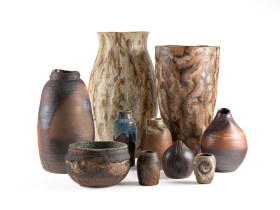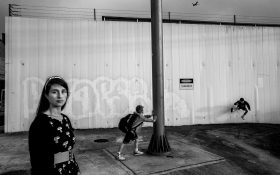Haegue Yang’s exhibition, Changing From From To From, opened this past week at the National Gallery of Australia (NGA). The occasion marked the announcement of the acquisition of several major artworks by Yang, which form this room-sized installation.
Living between Seoul and Berlin, Yang is a deeply celebrated and in high demand artist, who seeks out uncharted narratives, processes and materials, often combining industrial objects with craft-based techniques to question human/nature relationships.
Russell Storer, NGA’s Head Curator, International Art, says of the acquisition: ‘As a collecting institution it is important to recognise who we are in the Asia Pacific Region. Haegue is able to draw on those lineages and draw something new to those stories by working with sculpture in innovative ways.’
The first acquisition is a trio of sculptures that make up Sonic Intermediates – Three Differential Equations (2020), which are periodically activated during the exhibition. The second acquisition is a custom wallpaper, Non-Linear and Non-Periodic Dynamics (2020), which has been adapted for the NGA.
The earliest sculpture in the exhibition, Triple Chalkies (2015), has also entered the Collection through the Australian Government’s Cultural Gifts Program, and is a great example of Yang’s macramé-based works.
The artist says that she has a particular interest in ‘low-key weaving – crochet, needle kitting, cross stitch, macramé and straw weaving,’ and the notion of labour and craftsmanship attached to these materials – ‘especially macramé, which many know as a hobby in the 60s and 70s, but is no longer in vogue. It is very ornamental,’ she says.
Yang adds that as a contemporary artist, who has been schooled to be ‘hostile to ornamentation’, her aim is to keep ‘both intact in my work – both abstraction and ornamentation’ and to navigate the idea of whether they can co-exist.
This narrative is particularly resonant in Australia, where we have a strong support for experimental contemporary textiles, attested to by the recent win of the prestigious Archibald Prize with a textiles-based artwork.
The trio of kinetic sculptures for Sonic Intermediates – Three Differential Equations (2020) offer a nod to the great pioneering modern artists Barbara Hepworth, Naum Gabo and Li Yuan-chia, but are also a celebration of a ‘sense of movement and migration of working between cultures … crossing borders is really a central concern in Haegue’s work,’ explains Storer.
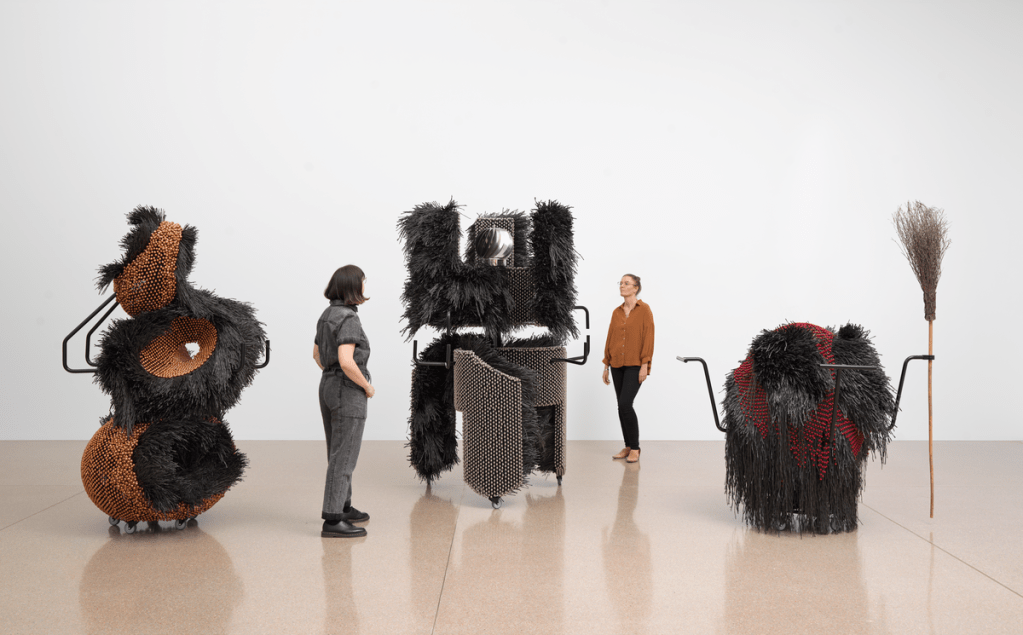
Storer says of the unspoken collaboration: ‘Each of these incredible artists were moving around and working outside the mainstream of the art system, and were really innovative in terms of sculpture.’
Yang says, ‘[I] rediscovered Hepworth during a visit to Cornwall (UK), where she lived and cultivated modernism far from London. She somehow drew my attention to Gabo, who for a period was a refugee in Cornwall and was supported by Hepworth and Ben Nicholson… It is also a compelling story about solidarity and different types of movement.
‘And the last figure, Li, is important to me because I often want to honour “not yet happened encounters” – the encounters that we can’t actually make by ourselves and are not historically proven.’
Yang says she fantasises that Li completes the trio as a non-compromising artist who locates himself globally.
These narratives of borders and crossings, of innovation and artistic flourishing through the help of others explored in Yang’s work, fit well within an Australian diaspora and culture of fluid identities.
Adding an Australian inflection for the National Collection
Completing these acquisitions for the Australian public is a wallpaper piece. Yang says that, for her, it ‘became an occasion for me to learn something new’.
The work was originally conceived after spending time in Cornwall’s rugged landscape, and was then developed for an exhibition at Tate St Ives. Storer says that when the gallery decided to show the wallpaper in Canberra, and bring it into the Collection, ‘Haegue wanted to draw reference to the local landscape and the local cultures here.’
The selection of local elements was made in consultation with Paul Girrawah House, Ngambri (Walgalu), Wallabalooa (Ngunnawal), Pajong (Gundungurra) and Wiradjuri (Erambie) peoples, and includes motifs of kurrajong trees, bogong moths, local water-related elements such as the Snowy River Scheme, Lake George and Lake Burley Griffin, and an iconic canoe.
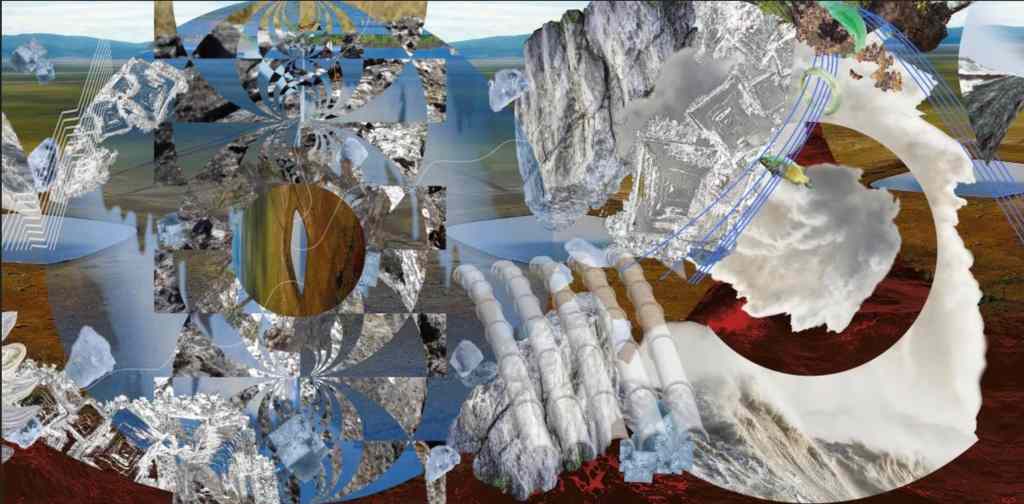
‘Whenever I go and make an exhibition, I am an outsider – I am an ignorant person who is not well-informed, so I need a learning process. Of course, my desire is to be integrated artistically by the local institution and the local informant,’ Yang says.
The central motif of the original wallpaper is water, while the hidden narrative is about movement, staring from an aerodynamic perspective and moving through to climate, and in particular the thinking of mathematician Edward Lorenz, who modelled the chaotic behaviour of weather.
Yang says the hardest transition making this work was moving from 3D, primarily as a sculptor, to making a densely layered image in a 2D format.
‘I normally don’t deal with flat surfaces. I had to think what it means to me. Flattening happens by making a photograph, and that is similar in the making process to abstraction – it is not real, it is imagery over reality. It functions in our head in the way we recognise certain imagery, but it loses the weight, the scale, the distance and the depth.’
Yang worked with AI text-to-image (TTI) technology to assist in the generation of the images. The wallpaper wraps from floor to ceiling around the space, immersing the viewer into Yang’s world of consideration.
Storer adds, ‘[Yang’s] works make connections between the divergent worlds of contemporary mass production, ancient cultural traditions and natural phenomena.’
Read: May budget to invest $535 million in cultural institutions
The role of the soundscape and AI for Haegue Yang
There are two soundtracks that are interwoven into the installation: one is a spoken monologue. ‘It sounds like Haegue, but it is actually an AI generated copy of Haegue’s voice, and is a meditation on how we try to name cyclones or typhoons to give a human structure to something unpredictable and chaotic,’ explains Storer.
The second is a recording of an historic summit between North and South Korea in 2018, which took place in the DMZ (Demilitarised Zone). The recording is from a moment when two of the leaders withdrew for 30 minutes in private discussion, and all that people could hear on the public broadcast was birdsong.
‘The mankind narrative got obscured and the sound of nature came to the surface,’ says Yang. ‘I got interested in that part of the recording, not only because I was one of millions following the summit and there was a lot on the internet speculating what the birds were singing, but I realised most of these were migrating birds, that were present at that moment in the DMZ.
‘It was the moment right at that point of conflict, which had been muted, so again this idea of the presence and the absence of two narratives that co-exist next to each other,’ she continues.
It is a fitting narrative for regional conversations, and is deeply layered across notions of global conflict, negotiation, migration, pressure points, nature and climate, non-human incursions and so on.
Read: Glancing in the rear-view mirror, while driving forward
‘Overall I think, not only me, but other artists too – we try to think very holistically, not only about civilisation and mankind, but increasingly including the non-human elements in our work, so that holistic thinking is maybe what this cynical voice is suggesting in the sound element to this installation.’
Yang concludes that the title of the exhibition draws from the poetry of Li Yuan-chia, and came as a suggestion from the curators. Initially uncomfortable to use a citation, she says, ‘It has grown on me. It is very simple, and it is changing from A to B right, but the author just uses ‘from’ in place of ‘A and B’. It really address the idea of the moment – from where to where, or whom to whom. It also shows how important curatorial support is, and to accept it.’
Haegue Yang: Changing From From To From is free to visit and is on display at the National Gallery in Kamberri/Canberra from 27 May to 24 September 2023.
Sonic Intermediates – Three Differential Equations (2020) will be activated each Saturday at 11am, 12pm, and 1pm.
Curators: Russell Storer, Head Curator, International Art, and Beatrice Thompson, Associate Curator, Asian and Pacific Art.
This conversation is an extract from a discussion between Russell Storer and Haegue Yang for the media preview at the National Gallery of Australia on 25 May 2023.
